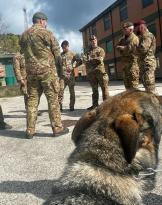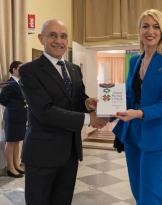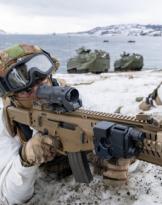"White Crane" or "White Crane". With this name was baptized the Italian joint humanitarian mission under the command of the Italian Navy which aboard Nave Cavour left La Spezia for Haiti, following the tragic 7.0 magnitude earthquake, which occurred on 12 January 2010.
The world woke up on the morning of January 13 to learn of the disaster, and that thousands of people - over 200 was the final toll - had lost their lives in what was one of the most devastating seismic events in history: cities and villages razed to the soil, interrupted communication routes and everywhere mud, rubble and desolation.
An entire country, already marked by an atavistic poverty, found itself after that tremendous shock emotionally and economically on its knees: between sufferers to bury and structures to rebuild.
International solidarity for that small state, bathed in the north by the Atlantic Ocean and in the south by the Caribbean Sea, was not long in coming and Italy decided to intervene and make its contribution - which later proved to be of essential importance - to the Haitian people. by sea, with the use of ship Cavour and the substantial aircraft component embarked.
 Set sail in the night between 18 and 19 January 2010 from the pier of Fincantieri di Muggiano (La Spezia) under the command of the vessel captain Gianluigi Reversi, the Cavour - New Major Unit (NUM) of the Navy - with its 245 meters in length and 27 thousand tons of weight, it embarked a national joint force device of almost 800 people, trucks, medical equipment and 6 medium helicopters, proceeding at a higher navigation speed at 27 knots, to cross the Atlantic and reach Port-au-Prince, the Haitian capital, in the shortest possible time.
Set sail in the night between 18 and 19 January 2010 from the pier of Fincantieri di Muggiano (La Spezia) under the command of the vessel captain Gianluigi Reversi, the Cavour - New Major Unit (NUM) of the Navy - with its 245 meters in length and 27 thousand tons of weight, it embarked a national joint force device of almost 800 people, trucks, medical equipment and 6 medium helicopters, proceeding at a higher navigation speed at 27 knots, to cross the Atlantic and reach Port-au-Prince, the Haitian capital, in the shortest possible time.
Operation "White Crane" represented Nave's operational baptism Cavour - conceived and built to meet the needs of the Italian Defense System - which raised the anchors for the first time in its history by carrying out humanitarian assistance and civil protection tasks, a function made possible thanks to its incontrovertible versatility of use .
The aircraft carrier Cavour - flagship of the naval units supplied to the Navy - it actually possesses command and control capabilities such as to make its use effective even in complex and multi-dimensional scenarios. Its structural characteristics are well known: it can carry up to 1200 men and 20 aircraft; its hangars can house vehicles, amphibious vehicles and materials; it has 2 medical clinics, 2 operating theaters, one for resuscitation, one for radiology, one for treating burns, 8 beds for intensive care, an analysis laboratory and a dental laboratory.
The "White Crane" task force was made up of the Navy, the Italian Army, the Air Force, the Carabinieri and the Italian Red Cross. On board the Cavour There was also a Brazilian contingent made up of 76 people: 45 units of the Carioca navy and 31 units of the integrated medical team, as well as 2 helicopters. An inter-force and international contingent, therefore, an expression of a shared solid will to support a severely tried and suffering country.
An international cooperation that proved to be effective in its aims and purposes, also performing tasks of public utility: delivering tons of basic necessities; provide medical and surgical assistance; restore the communication routes; rebuild infrastructure.
The Navy, in that operation, employed 643 soldiers (43 women), 50 riflemen from the San Marco regiment, 9 divers from the Underwater Operating Group and 85 helicopter pilots, who in the 59 days stationed in Haiti also contributed to restore hope. to the population still in shock from the catastrophe.
 The work of the whole team was exceptional, the missions carried out on site were commendable, such as the one that saw the EH-101 and SH-3D helicopters fly off the Nave flight deck. Cavour, at the base of the bay of Port-au-Prince, to supply the inhabitants of Baradères - a small village located 80 km southwest of the capital - with food, which has remained off the main communication routes and can only be reached by air.
The work of the whole team was exceptional, the missions carried out on site were commendable, such as the one that saw the EH-101 and SH-3D helicopters fly off the Nave flight deck. Cavour, at the base of the bay of Port-au-Prince, to supply the inhabitants of Baradères - a small village located 80 km southwest of the capital - with food, which has remained off the main communication routes and can only be reached by air.
Humanity and solidarity, brought to Haiti by the Italian Navy by sea and by air, with 63 flights performed by helicopters on board, configured ad hoc to better respond to the emergency, to carry out medical evacuations, recovering children, women and men - who remained injured following the earthquake - and treated by the medical team on board.
On April 14, 2010 Ship CavourAfter nearly three months of mission and 14.824 miles traveled for a total of 1900 engine hours, she returned to Italy, welcomed in the port of Civitavecchia by political and military authorities.
The extraordinary expeditionary characteristic of the Navy was tangible to everyone, even after that mission, with the forces and means to act quickly and independently, in every theater and in every circumstance.
The same aircraft carrier Cavour, a large and modern aircraft carrier, updated to operate with 5th generation aircraft, capable of acting "in attack", "in defense" and "in aid" reaching - in a short time - distant scenarios, whether war or of peace, confirm the native and recognized versatile and multifaceted connotation of the armed force.
Eleven years after that tragic episode as well as that necessary mission, the Navy still remembers the faces, eyes and smiles of the many people helped; remember the handshakes, hugs and greetings before returning to Italy.
Above all he remembers the motto and warning of the Haitian flag: "L'Union fait la force", or "Unity is strength".













